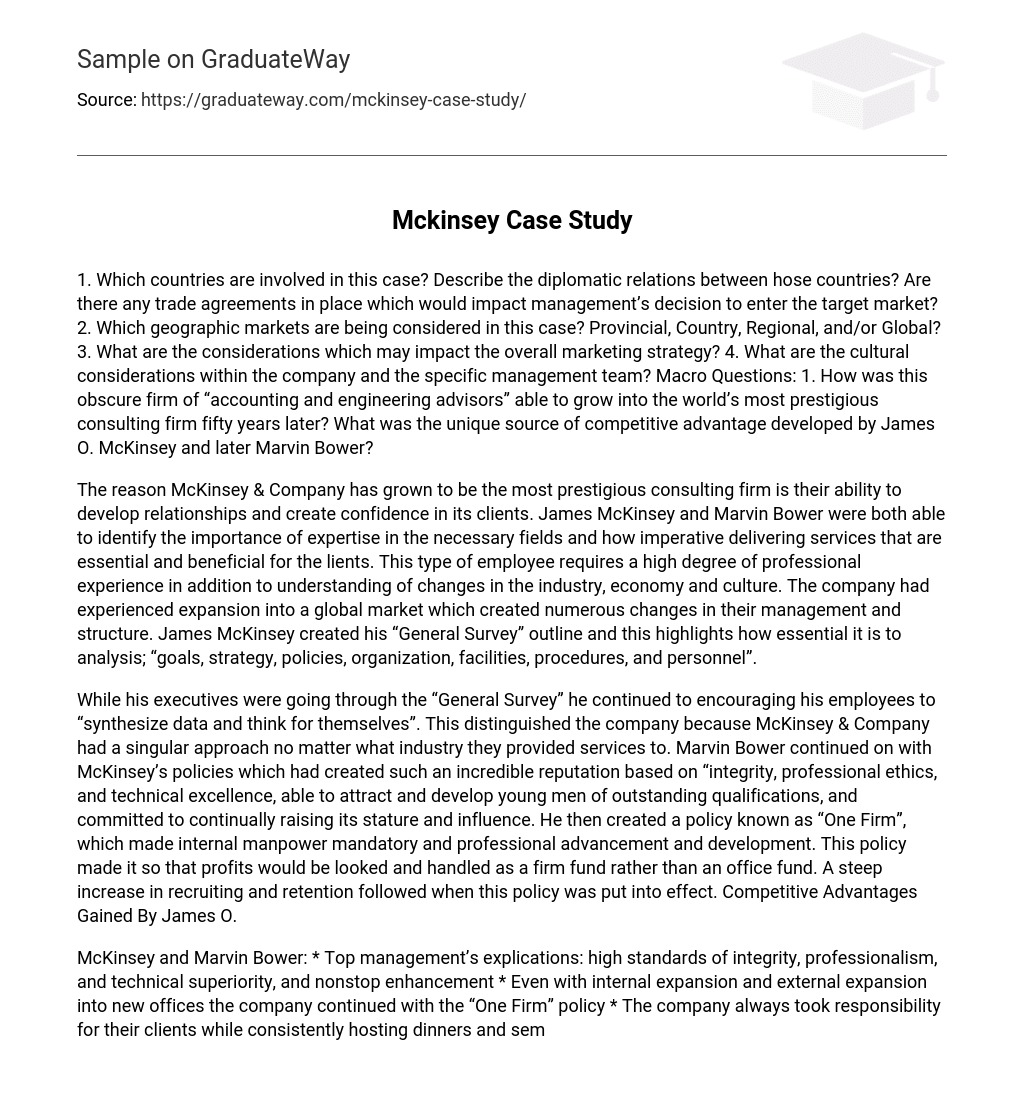1. Which countries are involved in this case? Describe the diplomatic relations between hose countries? Are there any trade agreements in place which would impact management’s decision to enter the target market? 2. Which geographic markets are being considered in this case? Provincial, Country, Regional, and/or Global? 3. What are the considerations which may impact the overall marketing strategy? 4. What are the cultural considerations within the company and the specific management team? Macro Questions: 1. How was this obscure firm of “accounting and engineering advisors” able to grow into the world’s most prestigious consulting firm fifty years later? What was the unique source of competitive advantage developed by James O. McKinsey and later Marvin Bower?
The reason McKinsey & Company has grown to be the most prestigious consulting firm is their ability to develop relationships and create confidence in its clients. James McKinsey and Marvin Bower were both able to identify the importance of expertise in the necessary fields and how imperative delivering services that are essential and beneficial for the lients. This type of employee requires a high degree of professional experience in addition to understanding of changes in the industry, economy and culture. The company had experienced expansion into a global market which created numerous changes in their management and structure. James McKinsey created his “General Survey” outline and this highlights how essential it is to analysis; “goals, strategy, policies, organization, facilities, procedures, and personnel”.
While his executives were going through the “General Survey” he continued to encouraging his employees to “synthesize data and think for themselves”. This distinguished the company because McKinsey & Company had a singular approach no matter what industry they provided services to. Marvin Bower continued on with McKinsey’s policies which had created such an incredible reputation based on “integrity, professional ethics, and technical excellence, able to attract and develop young men of outstanding qualifications, and committed to continually raising its stature and influence. He then created a policy known as “One Firm”, which made internal manpower mandatory and professional advancement and development. This policy made it so that profits would be looked and handled as a firm fund rather than an office fund. A steep increase in recruiting and retention followed when this policy was put into effect. Competitive Advantages Gained By James O.
McKinsey and Marvin Bower: * Top management’s explications: high standards of integrity, professionalism, and technical superiority, and nonstop enhancement * Even with internal expansion and external expansion into new offices the company continued with the “One Firm” policy * The company always took responsibility for their clients while consistently hosting dinners and seminars to create and keep good relationships and remain engaged with their clients and supply them with beneficial information * The company was recognized for visionary thinkers and an exceptional management structure * Granting profit is always imperative for a company it was not their solitary motivation * Uninterrupted enhancement in services supplied to the client and making certain the clients are satisfied was the company’s main motivation 2. How effective was Ron Daniel in leading McKinsey to respond to challenges identified in the Commission on Firm Aims and Goals? What contribution did Fred Gluck make to required changes? Ron Daniel came into the position of the Managing Director when McKinsey was dealing with the competition in the business consulting industry that was growing while the actual market in North America and Europe was declining.
Daniel had to respond to this drastic change in the market, he responded to this change by moving away from the policies the company already held and focused of skill sets specific to the company and development of expertise. Daniel then leveraged the firm’s functional knowledge, especially for strategy, operations, and organization sectors. Daniel had implemented an innovative approach that he and a colleagues had created referred to as the “Clientele Sectors”, this divided parts of the company into industry based part: * Consumer products * Banking * Industrial Goods * Insurance * Steel * Automotive * Chemicals * Health Care * Energy * Communications and Information * Electronics Fred Gluck was the first to lead a group in this approach. Gluck then created a “Centers of Competence”; he didn’t just create one but fifteen centers of competences.
The increasing number of “Clientele Industry Sectors” was the reasoning behind creating the “15 Centers of Competence” which like the “Clientele Sectors” were “visual centers” and not actual office locations. These “15 Centers of Competence” are: * Building Institutional skills * Strategic Management * Systems * Technology * Business Management Unit * Change Management * Corporate Leadership * Microeconomics * Sourcing * Corporate Finance * Diagnostic Scan * International Management * Marketing * Manufacturing * Integrated Logistics Gluck then build a “Knowledge Infrastructure” which he implemented by launching a “Knowledge Management Project”.
This consisted of building a corporate database of knowledge collected from the work of the clients in that particular practice. Gluck then hired a “full time practice coordinator” for each practice to ensure the quality of the work done. With this system in place career paths were created that could be specialized in that particular practice. 3. Judging by the evidence in the three mini-cases of front-line activities in the mid-1990 how effective has the firm been in its two-decade long change process? Each of the mini-cases illustrates the weaknesses and strengths of the systems or structures that the leaders of McKinsey & Company have used over the two-decades. “Jeff Peters and the Sydney Office Assignment”: This





